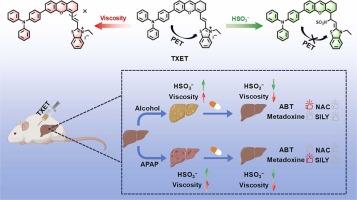A Dual-Responsive NIR Fluorescent Probe for Diagnosis and Therapeutic Evaluation of Alcoholic Liver Disease and Drug-Induced Liver Disease
IF 3.7
1区 化学
Q1 CHEMISTRY, ANALYTICAL
引用次数: 0
Abstract
Acute liver injury (ALI), including alcoholic liver disease (ALD) and drug-induced liver injury (DILI), poses significant diagnostic and therapeutic challenges because of the absence of specific biomarkers that distinguish it from other pathologies (e.g., acute lung or skeletal muscle injuries). Here, we report the synthesis of a probe, TXET, which exhibits dual responsiveness to viscosity and sulfur dioxide (SO2) derivatives. The probe’s carbon-carbon double bond undergoes a Michael addition reaction with bisulfite ion (HSO3−), blocking the photoinduced electron transfer (PET) process and enabling “off-on” detection of SO2 derivatives. Concurrently, as viscosity increases, rotation of the carbon-carbon bond in TXET is restricted, leading to the emission of intense red fluorescence. In vivo studies demonstrated that TXET can monitor dynamic changes in SO2 concentration and viscosity in ALD and DILI mice. Furthermore, TXET facilitated a comparative assessment of four drugs used in ALI treatment, revealing distinct therapeutic effects of these drugs in ALD and DILI models. This work highlights that TXET serves as a promising tool for the diagnosis of ALI and evaluation of therapeutic efficacy.

双响应NIR荧光探针对酒精性肝病和药物性肝病的诊断和治疗评价
急性肝损伤(ALI),包括酒精性肝病(ALD)和药物性肝损伤(DILI),由于缺乏将其与其他病理(如急性肺或骨骼肌损伤)区分开来的特异性生物标志物,给诊断和治疗带来了重大挑战。在这里,我们报道了一种探针TXET的合成,它对粘度和二氧化硫(SO2)衍生物具有双重响应性。探针的碳碳双键与亚硫酸氢离子(HSO3−)发生Michael加成反应,阻断了光诱导电子转移(PET)过程,实现了SO2衍生物的“off-on”检测。同时,随着粘度的增加,TXET中碳-碳键的旋转受到限制,从而发出强烈的红色荧光。体内研究表明,TXET可以监测ALD和DILI小鼠SO2浓度和黏度的动态变化。此外,TXET促进了四种用于ALI治疗的药物的比较评估,揭示了这些药物在ALD和DILI模型中的不同治疗效果。这项工作强调了TXET作为ALI诊断和治疗效果评估的一个有前途的工具。
本文章由计算机程序翻译,如有差异,请以英文原文为准。
求助全文
约1分钟内获得全文
求助全文
来源期刊

Sensors and Actuators B: Chemical
工程技术-电化学
CiteScore
14.60
自引率
11.90%
发文量
1776
审稿时长
3.2 months
期刊介绍:
Sensors & Actuators, B: Chemical is an international journal focused on the research and development of chemical transducers. It covers chemical sensors and biosensors, chemical actuators, and analytical microsystems. The journal is interdisciplinary, aiming to publish original works showcasing substantial advancements beyond the current state of the art in these fields, with practical applicability to solving meaningful analytical problems. Review articles are accepted by invitation from an Editor of the journal.
 求助内容:
求助内容: 应助结果提醒方式:
应助结果提醒方式:


